wheel CHEVROLET S10 1993 2.G Owners Manual
[x] Cancel search | Manufacturer: CHEVROLET, Model Year: 1993, Model line: S10, Model: CHEVROLET S10 1993 2.GPages: 356, PDF Size: 20.85 MB
Page 54 of 356
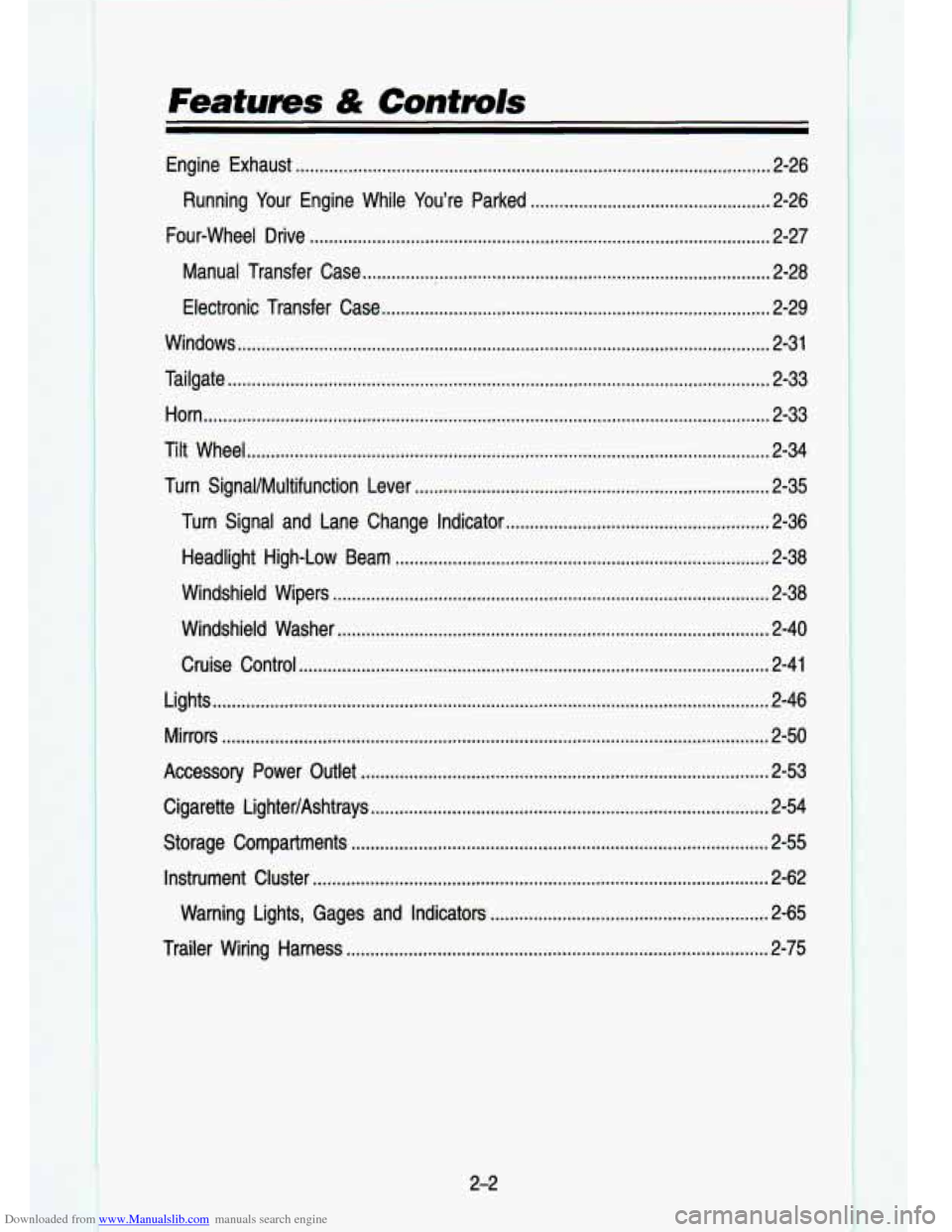
Downloaded from www.Manualslib.com manuals search engine Features & Controls
Enain laust ........................................................................\
........................... 2-26
hunnlng Your Engine While You’re Parked
.................................................. 2-26
Four-wheel Drive
........................................................................\
........................ 2-27
Manual Transfer Case
........................................................................\
............. 2-28
Electronic Transfer Case
........................................................................\
......... 2-29
Windows
........................................................................\
....................................... 2-31
Tailgate
........................................................................\
......................................... 2-33
Horn
........................................................................\
.............................................. 2-33
Tilt Wheel
........................................................................\
..................................... 2-34
Turn Signal/MuItifunction Lever
........................................................................\
.. 2-35
Turn Signal and Lane Change Indicator
....................................................... 2-36
Headlight High-Low Beam
........................................................................\
...... 2-38
Windshield Wipers
........................................................................\
................... 2-38
Windshield Washer
........................................................................\
.................. 2-40
Cruise Control
........................................................................\
.......................... 2-41
Lights
........................................................................\
............................................ 2-46
Mirrors
........................................................................\
.......................................... 2-50
Accessory Power Outlet
........................................................................\
............. 2.53
Cigarette LighteVAshtrays
........................................................................\
........... 2-54
Storage Compartments
........................................................................\
............... 2.55
Instrument Cluster
........................................................................\
................... I.rr . 2-62
Warning Lights, Gages and Indicators
.......................................................... 2-65
Trailer Wiring Harness
........................................................................\
................ 2-75
2-2
Page 60 of 356
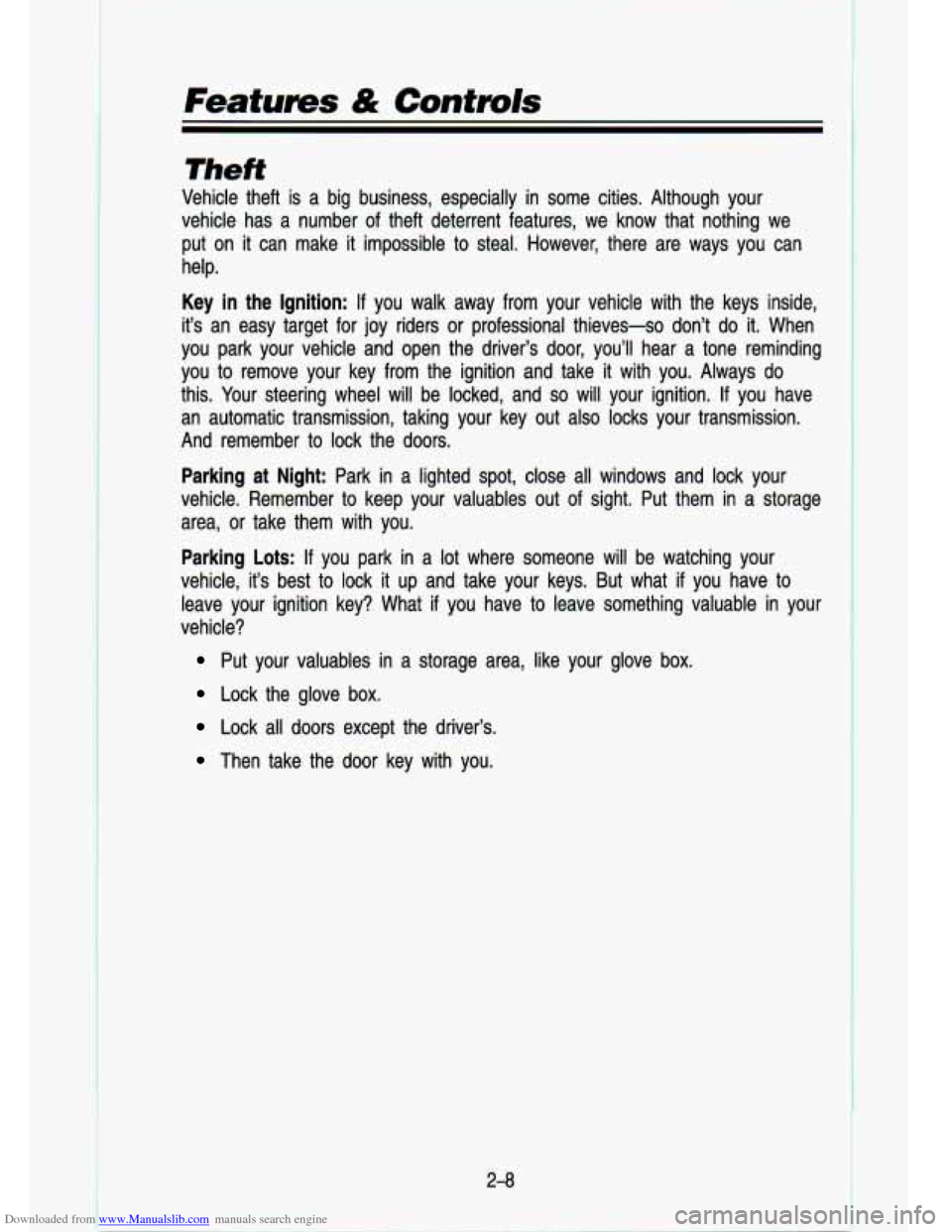
Downloaded from www.Manualslib.com manuals search engine Theft
Vehicle theft is a big business, especially in some cities. Although your
vehicle has a number of theft deterrent features, we know that nothing we
put on
it can make it impossible to steal. However, there are ways you can
help.
Key in the Ignition:
If you walk away from your vehicle with the keys inside,
it’s an easy target for joy riders or professional thieves-s\
o don’t
do it. when^
you park your vehicle and open the driver’s door, you’ll \
hear a tone reminding
you to remove your key from the ignition and take it with you. Always
do
this. Your steering wheel will be locked, and so will your ignition. If you have
an automatic transmission, taking your key out also locks your \
transmission.
And remember to lock the doors.
Parking at Night: Park in a lighted spot, close all windows and lock your
vehicle. Remember to keep your valuables out of sight. Put them in a storage
area, or take them with you.
Parking Lots:
If you park in a lot where someone will be watching your
vehicle, it’s best to lock it up and take your keys. But what
if you have to
leave your ignition key? What
if you have to leave somethina valuable in vour
vehicle?
Put your valuables in a storage area, like your glove DOX.
Lock the glove box.
Lock all doors except the driver’s.
Then take the door key with you.
2-8
1
Page 61 of 356
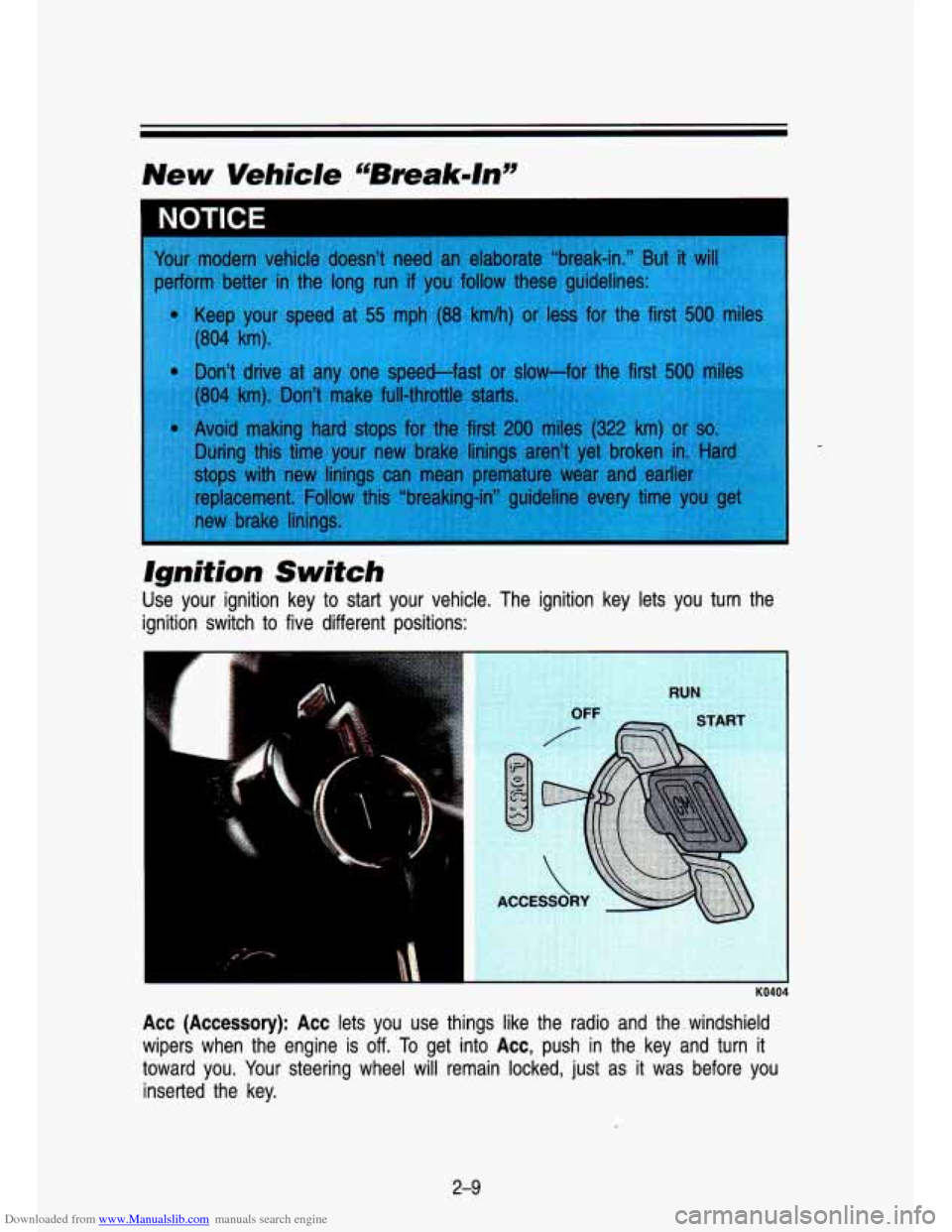
Downloaded from www.Manualslib.com manuals search engine New Vehicle c'Break-ln99
IYU I IW
ignition Switch
Use your ignition key to start your vehicle. The ignition key \
lets you turn the
ignition switch
to five different positions:
F
KO404
Acc (Accessory): Acc lets you use things like the radio and \
the windshield
wipers when the engine is
off. To get into Acc, push in the key and turn it
toward you. Your steering wheel will remain locked,
just as it was before you
inserted the key.
2-9
Page 62 of 356
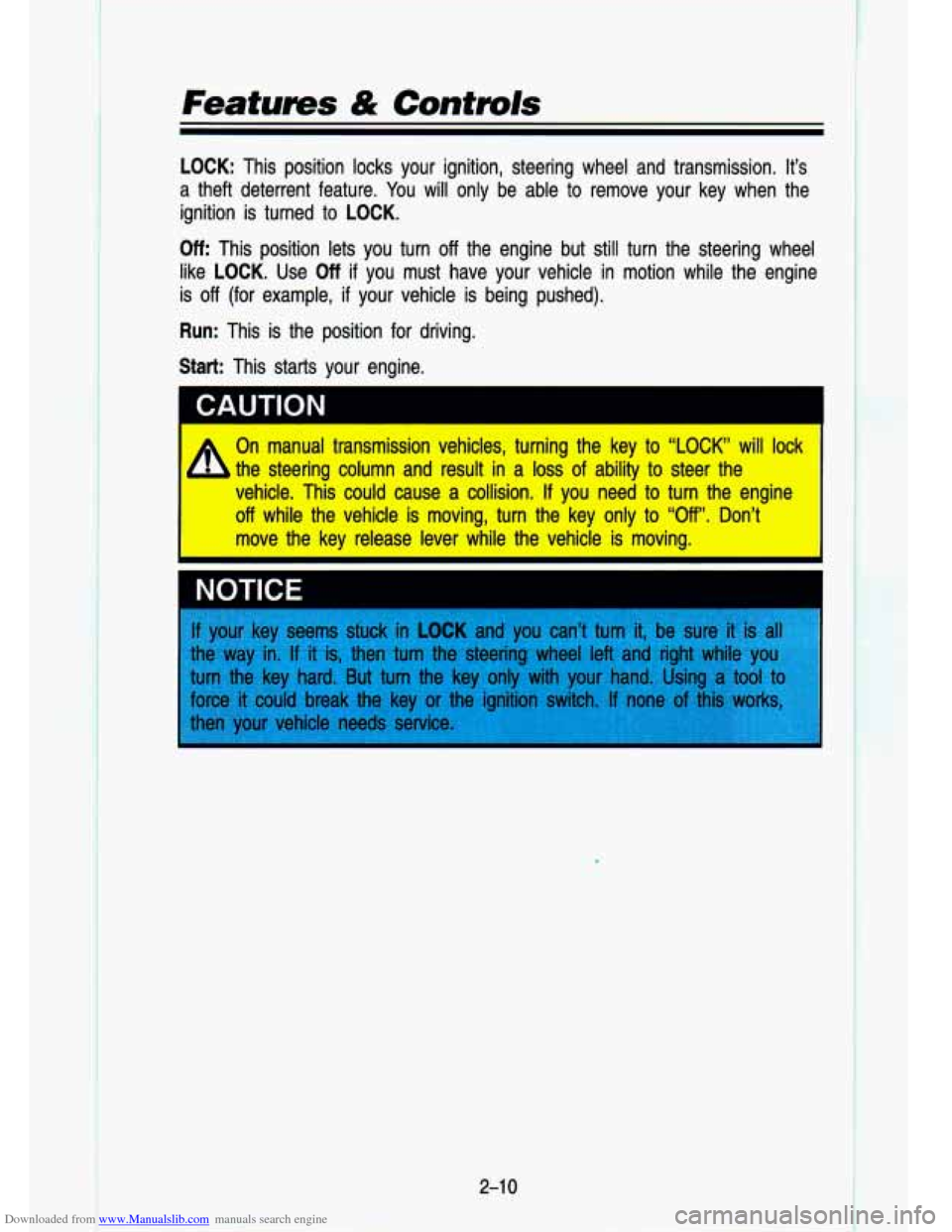
Downloaded from www.Manualslib.com manuals search engine .. ~ .
.. ..
Features & Contmls
LOCK: This position locks your ignition, steering wheel and tra\
nsmission. It’s
a theft deterrent feature. You will only be able to remove your key when the
ignition
is turned to LOCK.
Off: This position lets you turn off the engine but still turn the steering wheel
like LOCK. Use Off if you must have your vehicle in motion while the engine
is
off (for example, if your vehicle is being pushed).
Run: This is the position for driving.
Start: This starts your engine.
On manual transmission vehicles, turning the key to
“LOCK’ will lock
vehicle. This coiu18d cause am collision. If you need to turn the engiw
off Mhile the vehicle is moving, turn the key only to “OW. Don’t
mve the key release lever while the vehicle is moving.
- the steering column an’d result in a loss of ability to steer the
2-1 0
Page 69 of 356
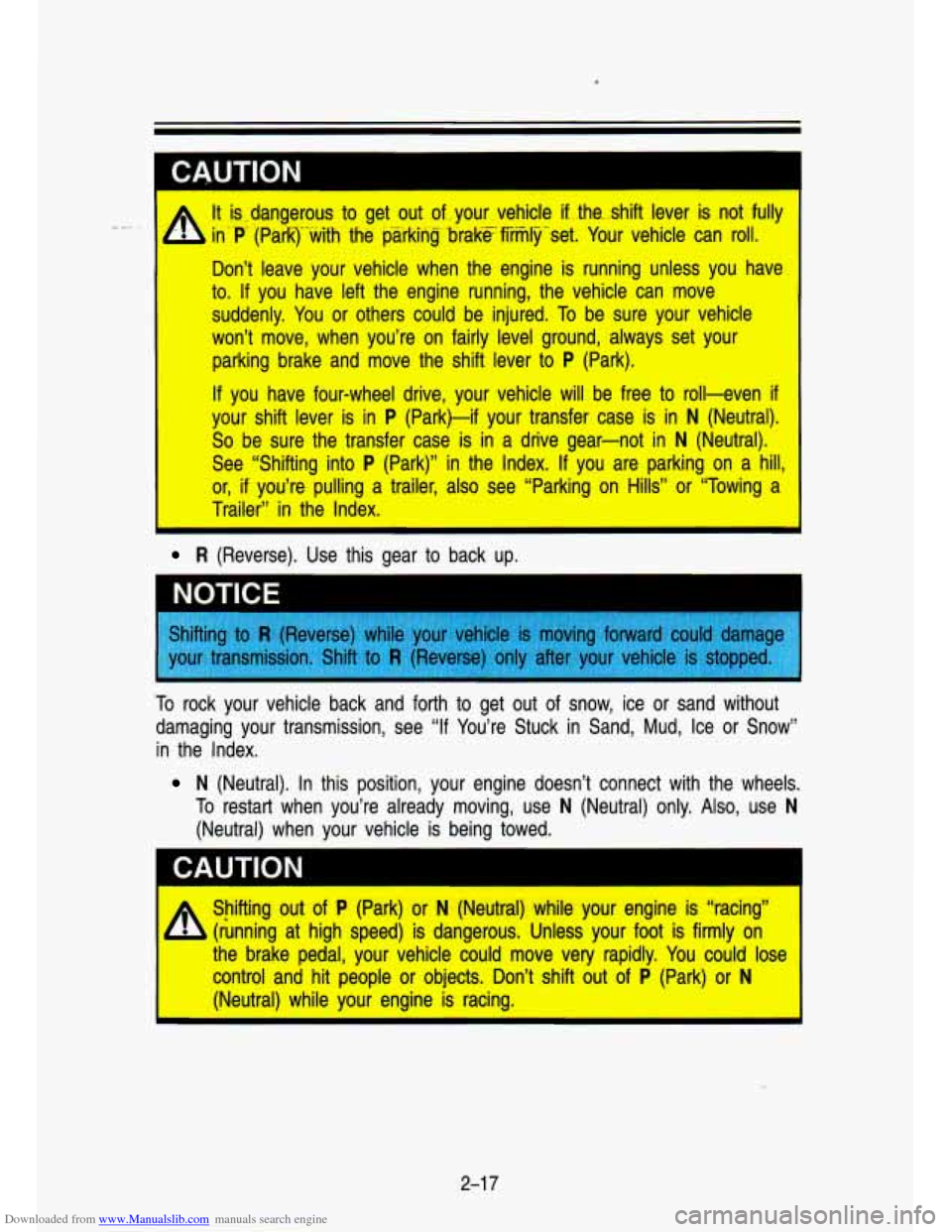
Downloaded from www.Manualslib.com manuals search engine I CAUTION
I A It is.-dangerous to get out of..your vehicle if. tha..shift lever is not fully
in-P (ParQ--wiih
the parking brake fiim~ljj-set. Yo’ur vehiclle ‘&n roll.
Doln’t leave your vehicle when the engine is running unless you have
to.
If you have left the engine running, tihe vehicle can move
suddenly. You or others could- be injured.
To be sure your vehicle
won’t move, when yolu’lre on fairly level ground, always set your
parking brake and move the shift lever to P (Park).
Of you have four-wheel drive, your vehicle will be free to roll-even if
your shift lever is in P (Park)i-if your transfer case i:s iln ‘N (Neutral).
So be sure the transfer case is in a drive gear-not in N (Neutral)’.
See “Shifting into P (Par’k)’’ in the Index. If you are ,parking on a hill,
or, if you’re p’ulling a traihr, also see “Parking on Hills” o:r “Towilnlg a
Trailer” in the Index.
R (Reverse). Use this gear to back up.
To rock your vehicle back and forth to get out of snow, ice or \
sand without
damaging your transmission, see
“If You’re Stuck in Sand, Mud, Ice or Snow”
in the Index.
N (Neutral). In this position, your engine doesn’t connect wi\
th the wheels.
To restart when you’re already moving, use N (Neutral) only. Also, use N
(Neutral) when your vehicle is being towed.
Shifting
out of P (Park) or N (Neutral) While your engine is “racing”
a (iunning aft hligh speed) is dangerous. ‘Unless your foot is firmly on
the brake ped’al,
your vehilcle could move very rapidly. You co1wl;d lose
(Neutral) while your engine is racing.
I contro’l and hit people or objects. Don’t shift out ‘of P (Park) or N
2-1 7
Page 70 of 356
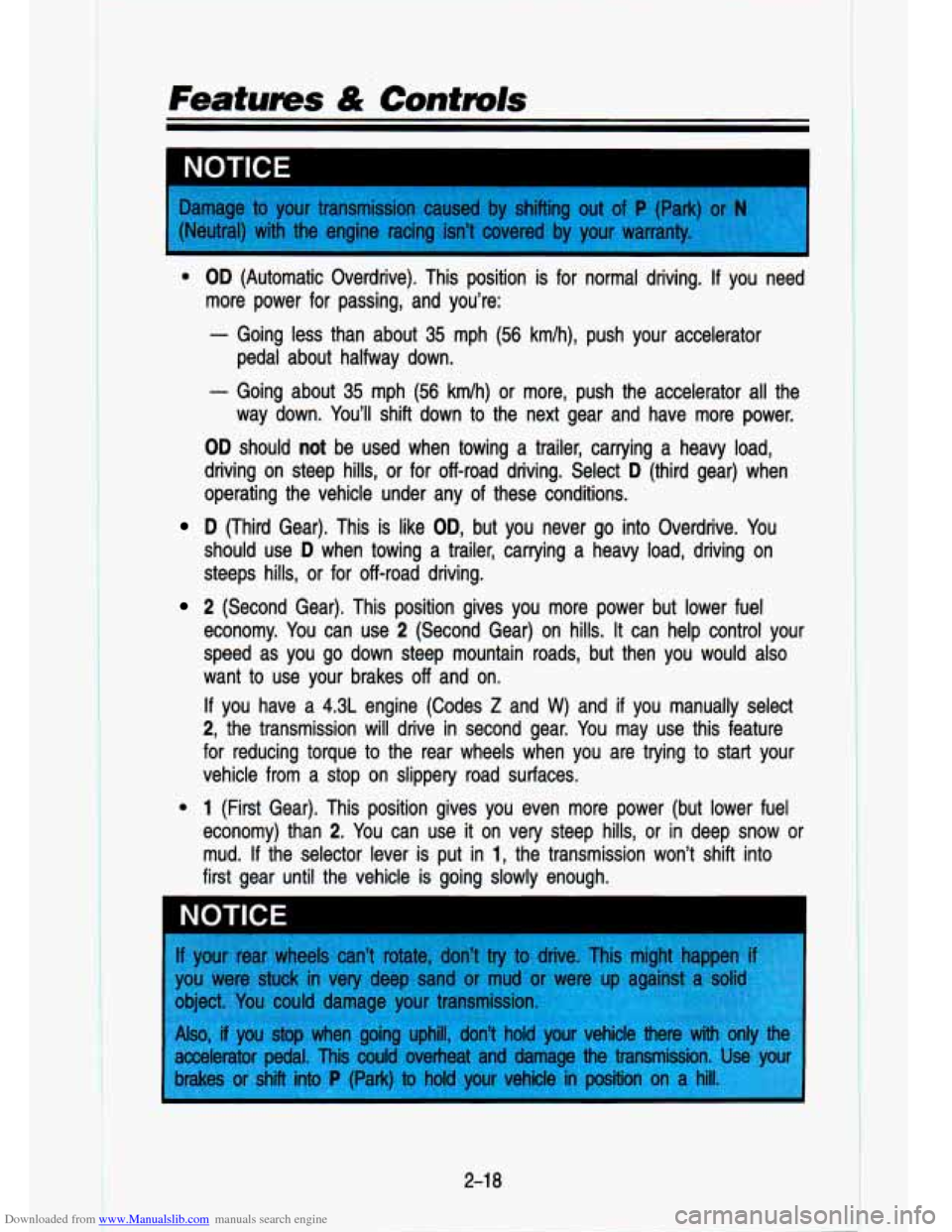
Downloaded from www.Manualslib.com manuals search engine Features & Controls
I
e
OD (Automatic Overdrive). This position is for normal driving. If you need
more power for passing, and you’re:
- Going less than about 35 mph (56 km/h), push your accelerator
pedal about halfway down.
- Going about 35 mph (56 km/h) or more, push the accelerator all the
way down. You’ll shift down to the next gear and have more power.
OD should not be used when towing a trailer, carrying a heavy load,
driving on steep hills, or for off-road driving. Select
D (third gear) when
operating the vehicle under any of these conditions.
D (Third Gear). This is like OD, but you never go into Overdrive. You
should use
D when towing a trailer, carrying a heavy load, driving on
steeps hills, or for off-road driving.
2 (Second Gear). This position gives you more power but lower \
fuel
economy. You can use
2 (Second Gear) on hills. It can help control your
speed as you go down steep mountain roads, but then you would\
also
want to use your brakes off and on.
If you have a 4.3L engine (Codes Z and W) and if you manually select
2, the transmission will drive in second gear. You may use this feature
for reducing torque
to the rear wheels when you are trying to start your
vehicle from a stop on slippery road surfaces.
1 (First Gear). This position gives you even more power (but \
lower fuel
economy) than
2. You can use it on very steep hills, or in deep snow or
mud. If the selector lever is put in 1, the transmission won’t shift into
first gear until the vehicle is going slowly enough.
2-1 8
Page 72 of 356
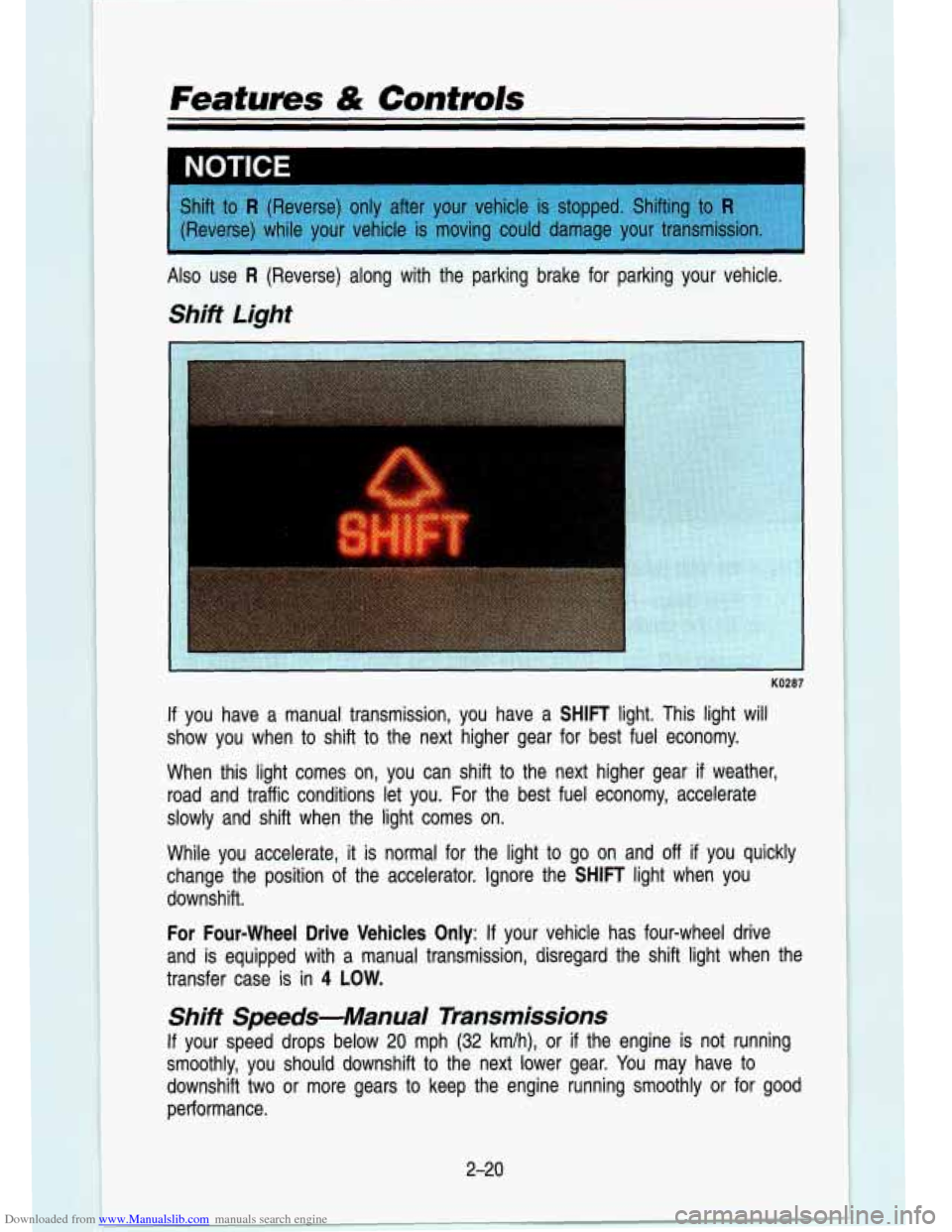
Downloaded from www.Manualslib.com manuals search engine Featurns & Controls
I
If you have a manual transmission, you have a SHIFT light. This light will
show you when
to shift to the next higher gear for best fuel economy.
When this light comes on,
you can "shift to the n-ext higher gear if weather,
road and traffic conditions let you. For the best fuel economy, accelerate
slowly and shift when the light comes on.
While you .accelerate, it
is normal for the light to go on and off if you quickly
change the position
of the accelerator. Ignore the SHIFT light when you
downshift.
For Four-wheel Drive Vehicles
Only: If your vehicle has four-wheel drive
and is equipped with a manual transmission, disregard the shift\
light when the
transfer case is in
4 LOW.
Shift Speeds-Manual Transmissions
If your speed drops below 20 mph (32 km/h), or if the engine is not running
smoothly, you should downshift
to the next lower gear. You may have to
downshift two or more gears to keep the engine running smoothly or for good
performance.
2-20
Page 73 of 356
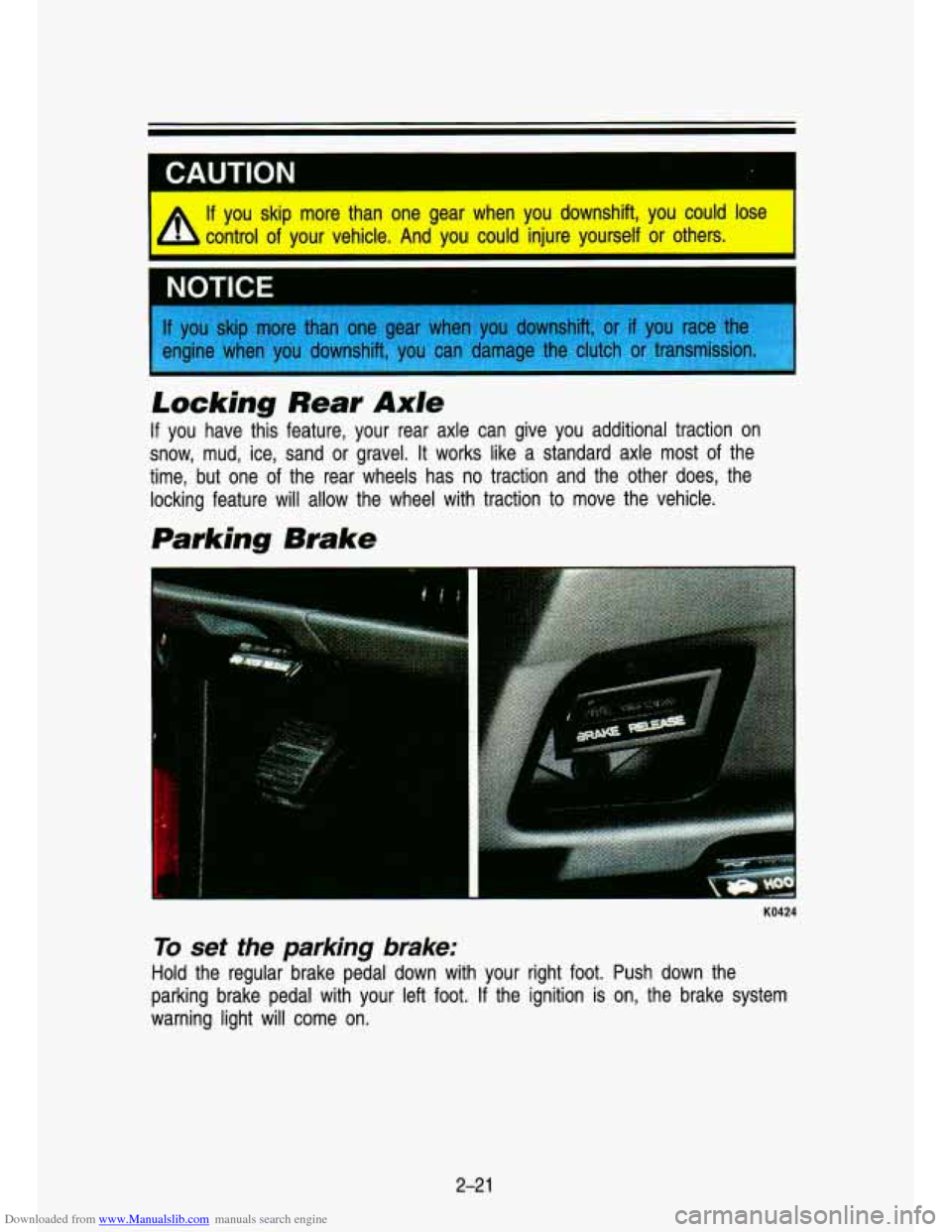
Downloaded from www.Manualslib.com manuals search engine CAUTION I
If you skip more than one gear when you downshift, you could lose
control of your vehicle. And you could injure yourself or others.
NOTICE
Locking Rear Axle
If you have this feature, your rear axle can give you additio\
nal traction on
snow, mud, ice, sand or gravel. It works like a standard axle\
most of the
time, but one of the rear wheels has no traction and the other does, the
locking feature will allow the wheel with traction to move the vehicle.
Parking Brake
KO424
To set the parking brake:
Hold the regular brake pedal down with your right foot. Push \
down the
parking brake pedal with your left foot.
If the ignition is on, the brake system
warning light will come on.
2-21
Page 74 of 356
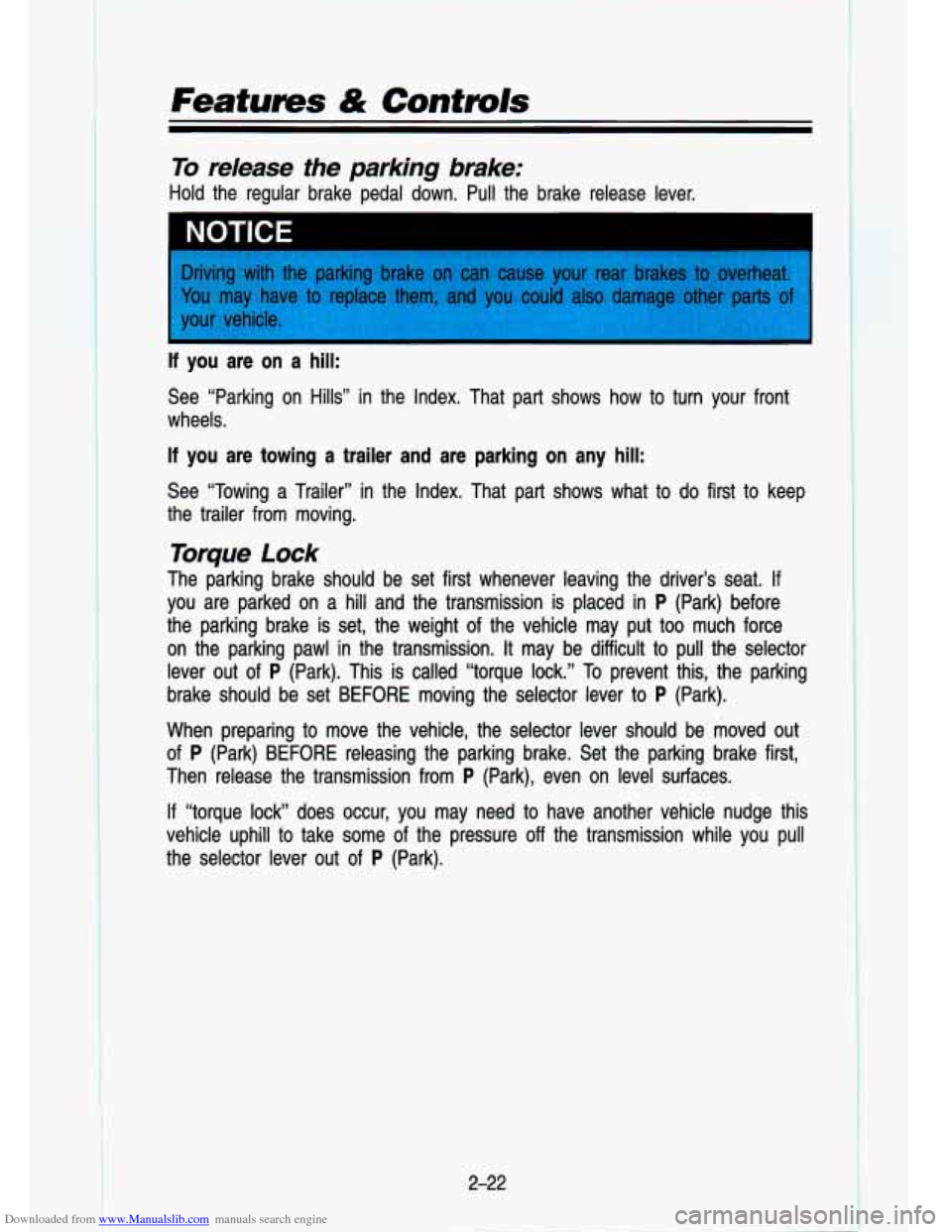
Downloaded from www.Manualslib.com manuals search engine Featums & Controls
To release the parking brake:
Hold the regular brake pedal down. Pull the brake release lever.
I NOTICE
If you are on a hill:
See “Parking on Hills” in the Index. That part shows how\
to turn your front
wheels.
If you are towing a trailer and are parking on any hill:
See “Towing a Trailer” in the Index. That part shows what to
do first to keep
the trailer from moving.
Torque Lock
The parking brake should be set first whenever leaving the driver’s seat. If
you are parked on a hill and the transmission is placed in P (Park) before
the parking brake is set, the weight of the vehicle may put too much force
on the parking pawl in the transmission.
It may be difficult to pull the selector
lever out of
P (Park). This is called “torque lock.” To prevent this, the parking
brake should be set BEFORE moving the selector lever
to P (Park).
When preparing to move the vehicle, the selector lever should \
be moved out of
P (Park) BEFORE releasing the parking brake. Set the parking br\
ake first,
Then release the transmission from
P (Park), even on level surfaces.
If “torque lock” does occur, you may need to have another vehicle nudge this
vehicle uphill to take some
of the pressure off the transmission while you pull
the selector lever out of
P (Park).
2-22
~
Page 75 of 356
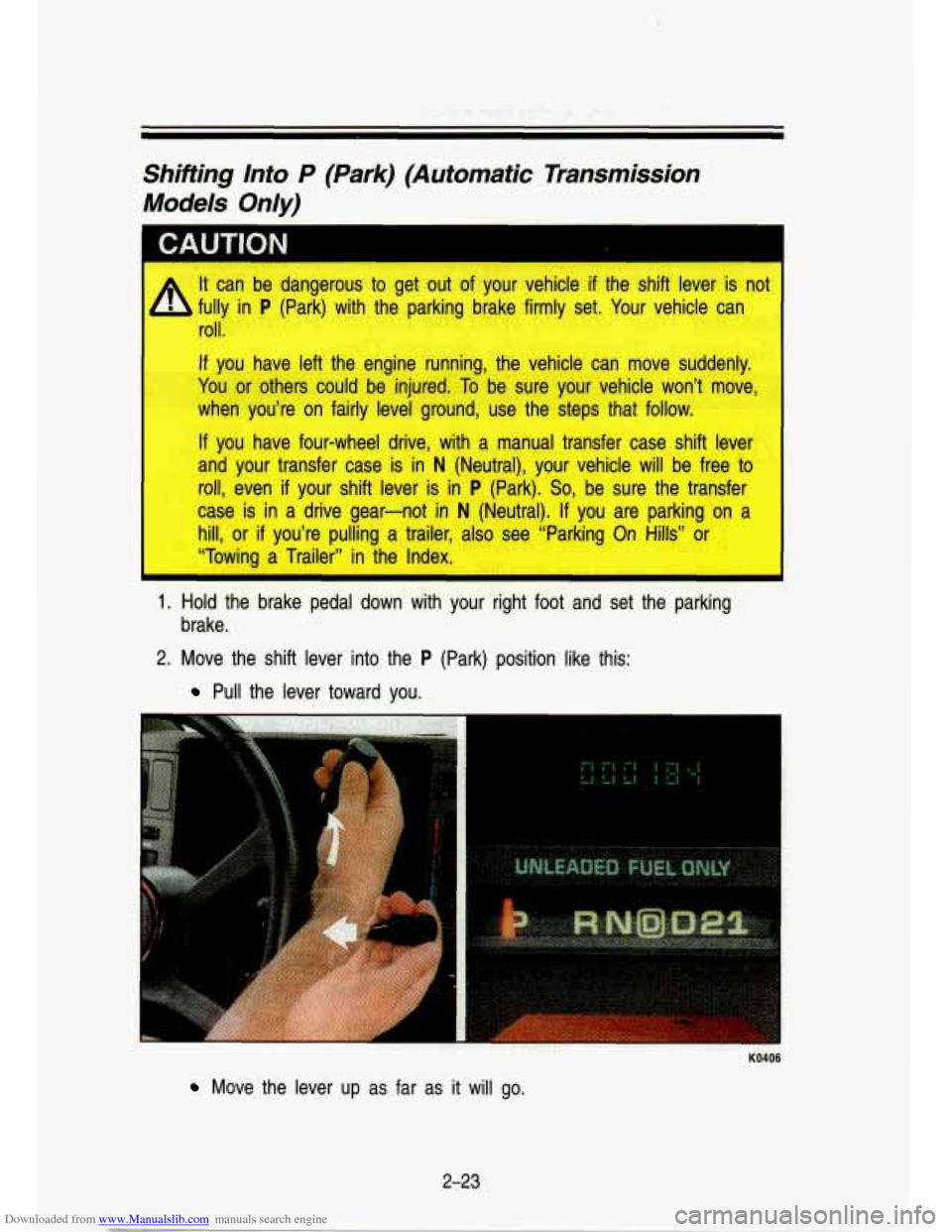
Downloaded from www.Manualslib.com manuals search engine Shifting Into P (Park) .(Automatic Transmission
Models Only)
fi A.UTION I.
It can be dangerous to get out of your vehicle if the shift lever is not I
fully in P (Park) with the parking brake firmly set. Your vehicle can
roll.
If you have left the engine running, the vehicle can move sudde..I,.
You or others could be injured.
To be sure your vehicle won’t move,
when you’re on fairly level ground, use the steps that foll\
ow.
If you have four-wheel drive, with a manual transfer case shif\
t lever
and your transfer case is in
N (Neutral), your vehicle will be free to
roll, even
if your shift lever is in P (Park). So, be sure the transfer
case is in a drive gear-not in
N (Neutral). If you are parking on a
hill, or
if you’re pulling a trailer, also see “Parking On Hills” or
“Towing a Trailer’’ in the Index.
1. Hold the brake pedal down with your right foot and set the parking
2. Move the shift lever into the P (Park) position like this:
brake.
Pull the lever toward you.
KO406
Move the lever up as far as it will go.
2-23